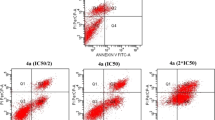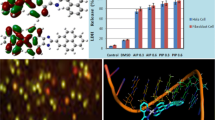Abstract
The structure–activity relationships of chiral 1,2-diaminophenylalkane platinum(II) anticancer derivatives are studied, including interactions with telomeric- and genomic-like DNA sequences, the pKa of their diaqua species, structural properties obtained from DFT calculations and resonant X-ray emission spectroscopy. The binding modes of the compounds to telomeric sequences were elucidated, showing no major differences with conventional cis-platinum(II) complexes like cisplatin, supporting that the cis-square planar geometry governs the binding of small Pt(II) complexes to G4 structures. Double-stranded DNA platination kinetics and acid–base constants of the diaqua species of the compounds were measured and compared, highlighting a strong steric dependence of the DNA-binding kinetics, but independent to stereoisomerism. Structural features of the compounds are discussed on the basis of dispersion-corrected DFT, showing that the most active series presents conformers for which the platinum atom is well devoid of steric hindrance. If reactivity indices derived from conceptual DFT do not show evidences for different reactivity between the compounds, RXES experiments provide new insight into the availability of platinum orbitals for binding to nucleophiles.










Similar content being viewed by others
References
Rosenberg B, Van Camp L, Krigas T (1965) Inhibition of cell division in Escherichia coli by electrolysis products from a platinum electrode. Nature 205:698–699
Deconti RC, Toftness BR, Lange RC, Creasey WA (1973) Clinical and pharmacological studies with cis-diamminedichloroplatinum(II). Cancer Res 33:1310–1315
Higby DJ, Wallace HJ, Albert DJ, Holland JF (1974) Diaminodichloroplatinum: a phase I study showing responses in testicular and other tumors. Cancer 33:1219–1225
Higby DJ, Wallace HJ, Holland JF (1973) Cis-diamminedichloroplatinum (NSC-119875): a phase I study. Cancer Chemother Rep 57:459–463
Rozencweig M, Von Hoff DD, Slavik M, Muggia FM (1977) Cis-diamminedichloroplatinum (II). A new anticancer drug. Ann Intern Med 86:803–812
Brayfield A (2007) Martindale: the complete drug reference. Pharmaceutical Press, London
Lippert B (1999) Cisplatin: chemistry and biochemistry of a leading anticancer drug. Wiley, Basel. doi:10.1002/9783906390420.ch10
Kelland LR, Farrell NP (eds) (2000) Platinum-based drugs in cancer therapy. Humana Press Inc., Totowa
Berger G, Gelbcke M, Cauët E et al (2013) Synthesis of 15N-labeled vicinal diamines through N-activated chiral aziridines: tools for the NMR study of platinum-based anticancer compounds. Tetrahedron Lett 54:545–548. doi:10.1016/j.tetlet.2012.11.079
Berger G, Gasper R, Lamoral-theys D et al (2010) Fourier transform infrared (FTIR) spectroscopy to monitor the cellular impact of newly synthesized platinum derivatives. Int J Oncol 37:679–686. doi:10.3892/ijo
Dufrasne F, Gelbcke M, Schnurr B, Gust R (2002) Synthesis and antitumor activity of enantiomerically pure [1,2-diamino-1-(4-fluorophenyl)propane]dichloroplatinum(II) complexes. Arch Pharm (Weinheim) 335:229–239. doi:10.1002/1521-4184(200205)335:5<229:AID-ARDP229>3.0.CO;2-Q
Dullin A, Dufrasne F, Gelbcke M, Gust R (2004) Enantiomerically pure [1, 2-diamino-1-(4-fluorophenyl)butane]platinum(II) complexes: synthesis and antitumor activity against MCF-7 and MDA-MB 231 breast cancer and LnCaP/FGC prostate cancer cell lines. Arch Pharm (Weinheim) 337:654–667. doi:10.1002/ardp.200400621
Dullin A, Dufrasne F, Gelbcke M, Gust R (2006) Synthesis and cytotoxicity of enantiomerically pure [1,2-diamino-1-(4-fluorophenyl)-3-methylbutane]platinum(II) complexes. ChemMedChem 1:644–653. doi:10.1002/cmdc.200600032
Berger G, Leclercqz H, Derenne A et al (2014) Synthesis and in vitro characterization of platinum(II) anticancer coordinates using FTIR spectroscopy and NCI COMPARE: a fast method for new compound discovery. Bioorg Med Chem 22:3527–3536. doi:10.1016/j.bmc.2014.04.017
Brouwer J, van de Putte P, Fichtinger-Schepmant AMJ, Reedijk J (1981) Base-pair substitution hotspots in GAG and GCG nucleotide sequences in Escherichia coli K-12 induced by cis-diamminedichloroplatinum (II). Proc Natl Acad Sci 78:7010–7014
Welters MJP, Fichtinger-schepman AMJ, Baan RA et al (1999) Pharmacodynamics of cisplatin in human head and neck cancer: correlation between platinum content, DNA adduct levels and drug sensitivity in vitro and in vivo. Br J Cancer 79:82–88
Jamieson ER, Lippard SJ (1999) Structure, recognition, and processing of cisplatin-DNA adducts. Chem Rev 99:2467–2498
Bischin C, Lupan A, Taciuc V, Silaghi-dumitrescu R (2011) Interactions between proteins and platinum-containing anti-cancer drugs. Mini Rev Med Chem 11:214–224
Casini A, Reedijk J (2012) Interactions of anticancer Pt compounds with proteins: an overlooked topic in medicinal inorganic chemistry? Chem Sci 3:3135. doi:10.1039/c2sc20627g
Karasawa T, Sibrian-Vazquez M, Strongin RM, Steyger PS (2013) Identification of cisplatin-binding proteins using agarose conjugates of platinum compounds. PLoS One. doi:10.1371/journal.pone.0066220
Pinato O, Musetti C, Sissi C (2014) Pt-based drugs: the spotlight will be on proteins. Metallomics 6:380–395. doi:10.1039/c3mt00357d
Mezencev R (2015) Interactions of cisplatin with non-DNA targets and their influence on anticancer activity and drug toxicity: the complex world of the platinum complex. Curr Cancer Drug Targets 14:794–816
Davis JT (2004) G-Quartets 40 years later: from 5′-GMP to molecular biology and supramolecular chemistry. Angew Chem Int Ed Engl 43:668–698. doi:10.1002/anie.200300589
Watson JD, Crick FHC (1953) Molecular structure of nucleic acids. Nature 171:737–738
Mergny J-L, Riou J-F, Mailliet P et al (2002) Natural and pharmacological regulation of telomerase. Nucleic Acids Res 30:839–865
Kim NW, Piatyszek MA, Prowse KR et al (1994) Specific association of human telomerase activity with immortal cells and cancer. Science 266:2011–2015
Hanahan D, Weinberg RA (2011) Hallmarks of cancer: the next generation. Cell 144:646–674. doi:10.1016/j.cell.2011.02.013
Parkinson GN, Lee MPH, Neidle S (2002) Crystal structure of parallel quadruplexes from human telomeric DNA. Nature 417:876–880. doi:10.1038/nature755
Wang Y, Patel DJ (1993) Solution structure of the human telomeric repeat d[AG3(T2AG3)3] G-tetraplex. Structure 1:263–282
Granotier C, Pennarun G, Riou L et al (2005) Preferential binding of a G-quadruplex ligand to human chromosome ends. Nucleic Acids Res 33:4182–4190. doi:10.1093/nar/gki722
Biffi G, Tannahill D, McCafferty J, Balasubramanian S (2013) Quantitative visualization of DNA G-quadruplex structures in human cells. Nat Chem 5:182–186. doi:10.1038/nchem.1548
Schaffitzel C, Berger I, Postberg J et al (2001) In vitro generated antibodies specific for telomeric guanine-quadruplex DNA react with Stylonychia lemnae macronuclei. Proc Natl Acad Sci 98:8572–8577. doi:10.1073/pnas.141229498
Gellert M, Lipsett MN, Davies DR (1962) Helix formation by guanylic acid. Proc Natl Acad Sci 48:2013–2018
Burger AM, Double JA, Newell DR (1997) Inhibition of telomerase activity by cisplatin in human testicular cancer cells. Eur J Cancer 33:638–644. doi:10.1016/S0959-8049(96)00521-7
Ourliac-garnier I, Charif R, Bombard S (2009) Telomeres and telomerase: potential targets for platinum complexes. In: Hadjiliadis N, Sletten E (eds) Metal Complex-DNA Interactions. Wiley, pp 209–235
Schwartz A, Sip M, Leng M (1990) Sodium cyanide: a chemical probe of the conformation of DNA modified by the antitumor drug cis-diamminedichloroplatinum(II). J Am Chem Soc 112:3673–3674. doi:10.1021/ja00165a070
Maxam AM, Gilbert W (1977) A new method for sequencing DNA. Proc Natl Acad Sci 74:560–564. doi:10.1073/pnas.74.2.560
Ourliac-Garnier I, Elizondo-Riojas M-A, Redon S et al (2005) Cross-links of quadruplex structures from human telomeric DNA by dinuclear platinum complexes show the flexibility of both structures. Biochemistry 44:10620–10634. doi:10.1021/bi050144w
Bertrand H, Bombard S, Monchaud D, Teulade-Fichou M-P (2007) A platinum-quinacridine hybrid as a G-quadruplex ligand. J Biol Inorg Chem 12:1003–1014. doi:10.1007/s00775-007-0273-3
Davies MS, Cox JW, Berners-Price SJ et al (2000) Equilibrium and kinetic studies of the aquation of the dinuclear platinum complex [[trans-PtCl(NH3)2]2(mu-NH2(CH2)6NH2)]2+: pKa determinations of aqua ligands via [1H,15N] NMR spectroscopy. Inorg Chem 39:1710–1715
Cubo L, Thomas DS, Zhang J et al (2009) [1H,15N] NMR studies of the aquation of cis-diamine platinum(II) complexes. Inorg Chim Acta 362:1022–1026. doi:10.1016/j.ica.2008.03.117
Chai J-D, Head-Gordon M (2008) Long-range corrected hybrid density functionals with damped atom-atom dispersion corrections. Phys Chem Chem Phys 10:6615–6620. doi:10.1039/b810189b
Dolg M, Cao X (2012) Relativistic pseudopotentials: their development and scope of applications. Chem Rev 112:403–480. doi:10.1021/cr2001383
Tomasi J, Mennucci B, Cammi R (2005) Quantum mechanical continuum solvation models. Chem Rev 105:2999–3093. doi:10.1021/cr9904009
Reed AE, Weinstock RB, Weinhold F (1985) Natural population analysis. J Chem Phys 83:735–746
Szlachetko J, Nachtegaal M, de Boni E et al (2012) A von Hamos X-ray spectrometer based on a segmented-type diffraction crystal for single-shot X-ray emission spectroscopy and time-resolved resonant inelastic x-ray scattering studies. Rev Sci Instrum 83:103105
Redon S, Bombard S, Elizondo-Riojas M-A, Chottard JC (2003) Platinum cross-linking of adenines and guanines on the quadruplex structures of the AG3(T2AG3)3 and (T2AG3)4 human telomere sequences in Na+ and K+ solutions. Nucleic Acids Res 31:1605–1613. doi:10.1093/nar/gkg259
Howe-Grant M, Lippard SJ (1980) Metallointercalation reagents: thiolato complexes of (2, 2′: 6′, 2′′-terpyridine)-platinum(II). Inorg Synth 20:101–105
Berners-Price SJ, Ronconi L, Sadler PJ (2006) Insights into the mechanism of action of platinum anticancer drugs from multinuclear NMR spectroscopy. Prog Nucl Magn Reson Spectrosc 49:65–98. doi:10.1016/j.pnmrs.2006.05.002
Appleton TG, Hall JR, Ralph SF, Thompson CSM (1989) NMR of acid-base equilibria and other reactions of ammineplatinum complexes with aqua and hydroxo ligands. Inorg Chem 28:1989–1993
Berners-Price SJ, Frenkiel TA, Frey U et al (1992) Hydrolysis products of cisplatin: pKa determinations via[1H, 15N] NMR spectroscopy. J Chem Soc, Chem Commun. doi:10.1039/C39920000789
Pearson RG (1963) Hard and soft acids and bases. J Am Chem Soc 85:3533–3539. doi:10.1021/ja00905a001
Parr RG, Yang W (1984) Density functional approach to the frontier-electron theory of chemical reactivity. J Am Chem Soc 106:4049–4050. doi:10.1021/ja00326a036
Parr RG, Szentpaly LV, Liu S (1999) Electrophilicity index. J Am Chem Soc 121:1922–1924. doi:10.1021/cr040109f
Chattaraj PK, Sarkar U, Roy DR (2006) Electrophilicity index. Chem Rev 106:2065–2091. doi:10.1021/cr040109f
Geerlings P, De Proft F, Langenaeker W (2003) Conceptual density functional theory. Chem Rev 103:1793–1873. doi:10.1021/cr990029p
Yang W, Mortier WJ (1986) The use of global and local molecular parameters for the analysis of the gas-phase basicity of amines. J Am Chem Soc 108:5708–5711. doi:10.1021/ja00279a008
Koopmans T (1934) Über die Zuordnung von Wellenfunktionen und Eigenwerten zu den Einzelnen Elektronen Eines Atoms. Physica 1:104–113. doi:10.1016/S0031-8914(34)90011-2
Gust R, Gelbcke M, Angemaier B et al (1997) The stereoselectivity of antitumor active [1,2-diamino-1-phenylpropane] dichloroplatinum(II) complexes. Inorg Chim Acta 264:145–160
Simon M, Schmitt T (eds) (2013) Progress in resonant inelastic X-ray scattering. Elsevier, Amsterdam, pp 1–182
Sa J, Szlachetko J, Kleymenov E et al (2013) Fine tuning of gold electronic structure by IRMOF post-synthetic modification. RSC Adv 3:12043–12048. doi:10.1039/C3RA40970H
Szlachetko J, Sá J, Nachtegaal M et al (2014) Real time determination of the electronic structure of unstable reaction intermediates during Au2O3 reduction. J Phys Chem Lett 5:80–84. doi:10.1021/jz402309s
Sa J, Kayser Y, Milne CJ et al (2014) Temperature-programmed reduction of NiO nanoparticles followed by time-resolved RIXS. Phys Chem Chem Phys 16:7692–7696. doi:10.1039/C3CP54622E
Hammer B, Norskov JK (1995) Why gold is the noblest of all the metals. Nature 376:238–240
Bligaard T, Nørskov JK, Dahl S et al (2004) The Brønsted-Evans-Polanyi relation and the volcano curve in heterogeneous catalysis. J Catal 224:206–217. doi:10.1016/j.jcat.2004.02.034
Ankudinov AL, Rehr JJ, Conradson SD (1998) Real-space multiple-scattering calculation and interpretation of X-ray-absorption near-edge structure. Phys Rev B 58:7565–7576. doi:10.1103/PhysRevB.58.7565
Rehr JJ, Albers RC (2000) Theoretical approaches to X-ray absorption fine structure. Rev Mod Phys 72:621–654. doi:10.1103/RevModPhys.72.621
Ankudinov AL, Rehr JJ, Low J, Bare SR (2001) Effect of hydrogen adsorption on the X-ray absorption spectra of small Pt clusters. Phys Rev Lett 86:1642–1645. doi:10.1103/PhysRevLett.86.1642
Summa N, Schiessl W, Puchta R et al (2006) Thermodynamic and kinetic studies on reactions of Pt(II) complexes with biologically relevant nucleophiles. Inorg Chem 45:2948–2959. doi:10.1021/ic051955r
Acknowledgments
The authors thank Elisa Torres for the pKa measurements completed in the framework of her graduation thesis.
Author information
Authors and Affiliations
Corresponding author
Electronic supplementary material
Below is the link to the electronic supplementary material.
Rights and permissions
About this article
Cite this article
Berger, G., Fusaro, L., Luhmer, M. et al. Insights into the structure–activity relationships of chiral 1,2-diaminophenylalkane platinum(II) anticancer derivatives. J Biol Inorg Chem 20, 841–853 (2015). https://doi.org/10.1007/s00775-015-1270-6
Received:
Accepted:
Published:
Issue Date:
DOI: https://doi.org/10.1007/s00775-015-1270-6




